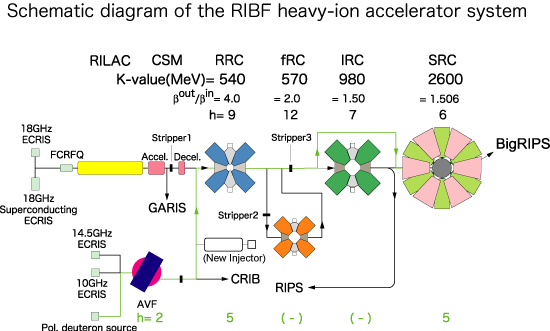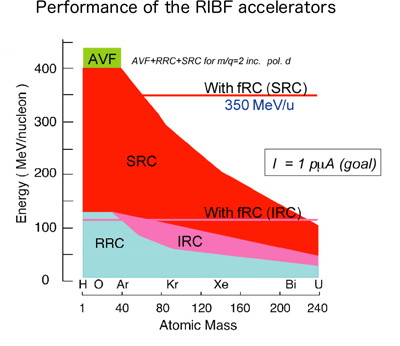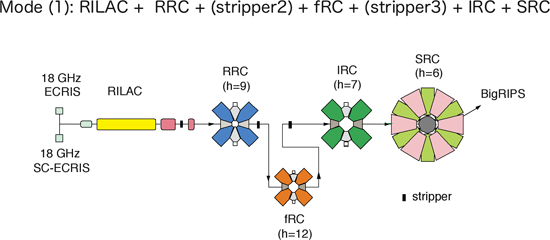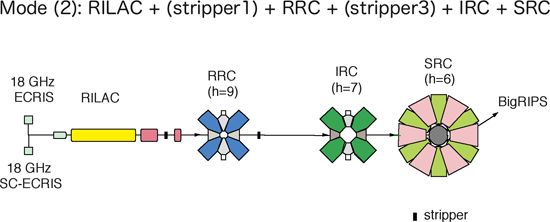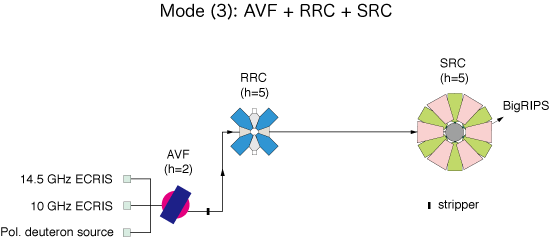| Facility Information |
| User Guide |
| PAC |
| Beam Time Operation |
| RIBF User Group |
| Collaboration |
| Seminars |
| Links |
| Archives |
|
Accelerator
 |
||||
Concept
The existing facility has three kinds of accelerators: the RILAC, the RRC, and the AVF.
The RILAC, which was completed in 1981, is a heavy-ion linac having six variable-frequency resonators. It was designed as the first injector to the RRC. It had been providing heavy-ion beams with almost the entire mass range with energies up to 2.5 MeV/nucleon. After six second-harmonic resonators were added as an energy booster after the RILAC in 2000, the maximum energy has been upgraded to 6 MeV/nucleon. These energy boosters were introduced as the acceleration part of the Charge-State Multiplier (CSM), which was constructed in collaboration with the Center for Nuclear Study (CNS).
The AVF, which was designed as the second injector of the RRC, was completed in 1989. It is a K70 AVF cyclotron, having four spiral sectors and two rf dees. The AVF can accelerate ions having a mass-to-charge ratio smaller than 4, up to 3.8 MeV/nucleon (at 12 MHz) and to 14.5 MeV/nucleon (at 24 MHz). Two types of ion sources, a 10 GHz ECR ion source and a polarized ion source are placed on the floor above the cyclotron vault. In the collaboration with the CNS, a new 14 GHz ECR ion source was installed in the injection line of the AVF and a flattop resonator was added to the rf system of the AVF.
The RRC, which was completed in 1986 as the main accelerator, is a K540 ring cyclotron having four separated-sector magnets and two rf resonators. In the case of the RILAC-RRC mode, the operational frequencies of the two accelerators are the same, and the harmonic number of the RRC is 9, 10, 11, or 12 according to injection energy. In 1987, the RRC began to deliver beams for experiments. The RRC reached to its full performance in 1989, when the AVF was completed. In the case of the AVF-RRC operation, the rf of the AVF is 1/2 sub-harmonic of that of the RRC, and the harmonic number of the RRC is five. After the energy booster was installed in the RILAC, the operation of the RRC with the harmonic number of 8 has become available. The RRC have been supplying a number of kinds of beams since 1986. They are plotted in a mass-energy plane as shown in Figure. The accelerated beams cover the entire energy-mass range according to the initial design for both the RILAC-RRC and AVF-RRC schemes. Energies of 63 MeV/nucleon for 40Ar, 48Ca, 58Fe, 86Kr, etc. have recently been available by operation of the RILAC-RRC with a harmonics of 8.
At the beginning, the RRC beams with a bottom energy were frequently used for super-heavy element research at E1. Considering the acceleration efficiency, the GARIS was moved to a RILAC target room. The research experiments on a Z=113 element have been carried out at the GARIS since 2003. The high-intensity 70Zr beam with an energy of 5 MeV/nucleon has been supplied on a rotating bismuth target of the GARIS in the e3 beam line of the RILAC more than 110 days from September 2003 to April 2005. Eventually two candidates of Z=113 element were detected so far.
The newly constructed RIBF accelerators consist of fRC, IRC
and SRC.
The fRC is a four-sector room-temperature ring cyclotron, which
is designed as a fixed frequency machine, unlike other cyclotrons
in the RIBF, so as to minimize its construction cost. The K-value
of the fRC is 570 MeV, which corresponds to the bending power
of 50.7 MeV/nucleon 238U72+. The frequency
of the fRC is determined at 55 MHz, which is three times those
of the RILAC and the RRC, so as to obtain high acceleration
voltage in the main rf resonator with small mechanical size
and low rf power.
The IRC is a room temperature ring cyclotron with K-980 MeV,
which is placed upstream of the SRC. The injector of the IRC
is the RRC (variable energy acceleration mode) or the fRC (345
MeV/nucleon mode). The maximum energy is 127 MeV/nucleon. The
IRC mainly consists of four sector magnets, beam injection
and extraction elements, two acceleration resonators and one
flattop rf resonator. The IRC was completed in 2005.
The SRC, which is the world’s first superconducting ring cyclotron with the ever
largest K-value of 2,600 MeV, mainly consists of six superconducting sector magnets,
four main rf resonators, one flattop rf resonator, injection and extraction elements
(among them the injection bending magnet (SBM) is superconducting). The valley
regions are covered with magnetic shield irons in order to reduce the stray field.
The sector magnets of the SRC was cooled down to 4.5 K and excited at the designed
maximum field of 3.8 T for the first time in November 2005. The whole components
of the SRC were completed in October 2006.
At the start of the commissioning, we set the ion type for the first beam to be uranium. The commissioning of the fRC started in July 2006 with the acceleration of a uranium beam. The uranium ion beam passed through the electrostatic deflector of the fRC for the first time on July 21. From September to November, acceleration tests of the fRC using a uranium beam continued to be performed, in between which experiments using the existing facility were conducted. The commissioning of the IRC started after the rooms for the IRC and SRC were designated to be a radiation-controlled area on November 22. For the tuning of the IRC, it was decided that a krypton beam would be used, taking the low intensity of the uranium beam into account. The krypton ion beam was accelerated and extracted from the IRC for the first time on November 25. The acceleration of the krypton beam was performed by bypassing the fRC (mode (2). For the commissioning of the SRC, the beam was switched to an aluminum beam on December 13, which was expected to have higher intensity than the krypton beam. The acceleration of the aluminum beam was also performed in the mode (2). The aluminum ion beam with the energy of 345 MeV/nucleon was successfully extracted from the SRC for the first time on December 28 at 16:00. On March 12, 2007, the first krypton beam with the same energy was extracted from the SRC; the first RI beams were generated and identified by the BigRIPS on March 15. Then, on March 23, a uranium beam was accelerated (mode (1)) for the first time up to 345 MeV/nucleon with the SRC, and were successfully identified a large variety of RI beams produced via the inflight-fission of the uranium beam. And eventually, a new very neutron-rich isotope, 125Pd, was discovered in the first test experiment using the uranium beam that was performed in March-June 2007.
A schematic diagram of the RIBF heavy-ion accelerator system is shown in Figure. In this diagram, a K-value and a velocity gain factor of each cyclotron are shown. Several acceleration modes will be available. Mode (1) (Figure): RILAC+ RRC+ (stripper2) + fRC+ (stripper3)+ IRC+ SRC is used for the RI-beam generation at 345 MeV/nucleon (fixed energy). 115 MeV/nucleon output beams from the IRC can be transferred to the existing RIPS in the future. Mode (2) (Figure): RILAC+ (stripper1) + RRC+ (stripper3)+ IRC+ SRC is used for variable energy experiments. Mode (3) (Figure): AVF+ RRC+ SRC is used for polarized deuteron beam generation at 880 MeV. The harmonic numbers for respective operation modes are also shown. The acceleration performance of the RIBF is summarized in Figure.
